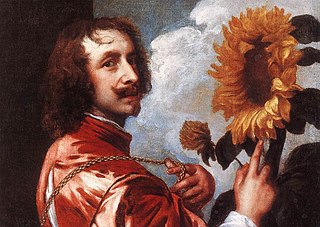
Sir Anthony van Dyck was a Flemish Baroque artist who became the leading court painter in England after success in the Spanish Netherlands and Italy.

Sir Robert Shirley was an English traveller and adventurer, younger brother of Sir Anthony Shirley and Sir Thomas Shirley. He is notable for his help modernising and improving the Persian Safavid army according to the British model, by the request of Shah Abbas the Great. This proved to be highly successful, as from then on the Safavids proved to be an equal force to their archrival, the Ottoman Empire.
Events from the year 1641 in art.
Events from the year 1620 in art.

Christopher Paul Hadley Brown, CBE is a British art historian and academic. He was director of the Ashmolean Museum in Oxford, England from 1998 to 2014. He is recognised as an authority on Sir Anthony van Dyck.

Theodosius and Saint Ambrose is a painting by Peter Paul Rubens, with assistance from his main pupil Anthony van Dyck, executed c. 1615–1616. It is now in the Kunsthistorisches Museum in Vienna. Rubens created the preparatory drawing, with the painting almost entirely done by van Dyck, who painted his own similar version of the subject a few years later. In the Rubens version, the architectural background is less defined, Theodosius is bearded and the spear and halberd in van Dyck's own version are omitted.

Saint Ambrose barring Theodosius from Milan Cathedral is a painting of c. 1619–20 by Anthony van Dyck in the National Gallery, London.
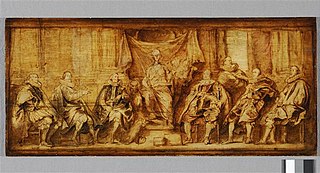
Magistrates of Brussels was a 1634-35 oil painting by Anthony van Dyck. It was destroyed in the French bombardment of Brussels in 1695. Its composition is known from a grisaille sketch in the École nationale supérieure des Beaux-Arts in Paris, which Van Dyck prepared to show how he planned to lay out the work.

Cupid and Psyche is an oil on canvas painting by Anthony van Dyck. It is now in the Royal Collection and shown in Kensington Palace.

Madonna and Child with Two Donors or The Madonna of the Two Donors is a 1630 painting by Anthony van Dyck, now in the Louvre, in Paris.
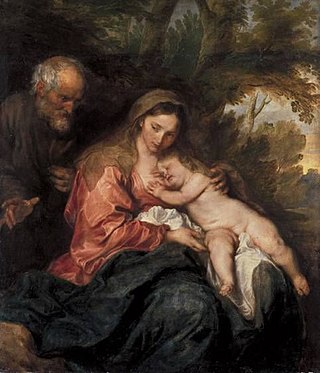
Rest on the Flight into Egypt is a 1630 painting by Anthony van Dyck, probably commissioned by a layman. Featuring the Holy Family of Joseph, Mary, and Jesus, it was owned by Maximilian II Emanuel, Elector of Bavaria and is now in the Alte Pinakothek in Munich. The Rest on the Flight into Egypt was a popular subject in art.
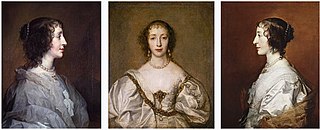
The Triple Portrait of Henrietta Maria is a 1638 painting by Antony van Dyck showing Henrietta Maria, wife of Charles I of England. Charles had previously commissioned van Dyck to produce a triple portrait of himself to send to Italy so that Bernini could produce a bust of him. When the bust arrived, the queen ordered a bust of herself by Bernini and commissioned van Dyck to produce a similar triple portrait. The left-facing profile and full-on view are in the Royal Collection, whilst the right-facing profile is probably the portrait of the queen now in the Memphis Brooks Museum of Art.

St Martin Dividing his Cloak is a painting by the Flemish painter Anthony van Dyck dated around 1618, which is an altarpiece in the Sint-Martinuskerk in Zaventem, Belgium. The painting portrays the story of Saint Martin sharing his cloak with a beggar. This early work of van Dyck was painted when he was strongly influenced by Rubens's style.

The Self-portrait of 1613–1614 is the first surviving self-portrait by the Flemish artist Anthony van Dyck, showing him aged about fifteen. At that date he was still working for Hendrick van Balen but was about to join Peter Paul Rubens's studio. Self-portraiture was a typical artform in the Northern Renaissance and had already been used by Rubens and Jan van Eyck.
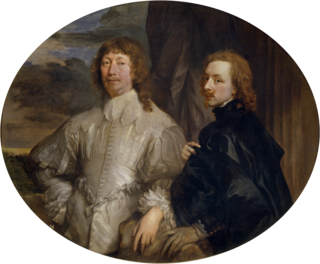
Self-portrait with Sir Endymion Porter is a self-portrait by Anthony van Dyck, showing him with his patron Sir Endymion Porter.

Self-Portrait with a Sunflower is a self-portrait by Anthony van Dyck, a Flemish Baroque artist from Antwerp, Spanish Netherlands. The oil on canvas is thought to have been painted between the years 1632 and 1633. Produced at the height of his fame, Anthony van Dyck served as "principal Paynter in order to their Majesties" in the court of Charles I of England whilst working on this self-portrait. The symbolism behind the sunflower and gold chain have been a point of contention amongst various art historians. His successful ventures in the southern part of the Netherlands and Italy propelled him into a career as court painter and made him a favourite of King Charles I and his court. Van Dyck's devotion for capturing the likeness of his models gave him authority over the world of portraiture long after his death in 1641. With such a long and storied career in art, his portrait technique evolved into what is referred to as his Late English period as seen in Self-Portrait with a Sunflower. This work is now in the private collection of the Duke of Westminster, housed at Eaton Hall in Cheshire.

The Three Eldest Children of Charles I is an oil painting on canvas of 1635 by Anthony van Dyck in the Galleria Sabauda in Turin.

The Three Eldest Children of Charles I is an oil painting on canvas by Anthony van Dyck, produced between November 1635 and March 1636 and still in the Royal Collection. Numerous studio copies were made of this painting.

Equestrian Portrait of Francisco de Moncada is a 1634 oil on canvas painting by Antony van Dyck, one of his most famous portraits, now INV 1240 in Room 850 (d) of the Louvre Museum, which acquired it from the Palazzo Braschi in Rome in 1798.
















